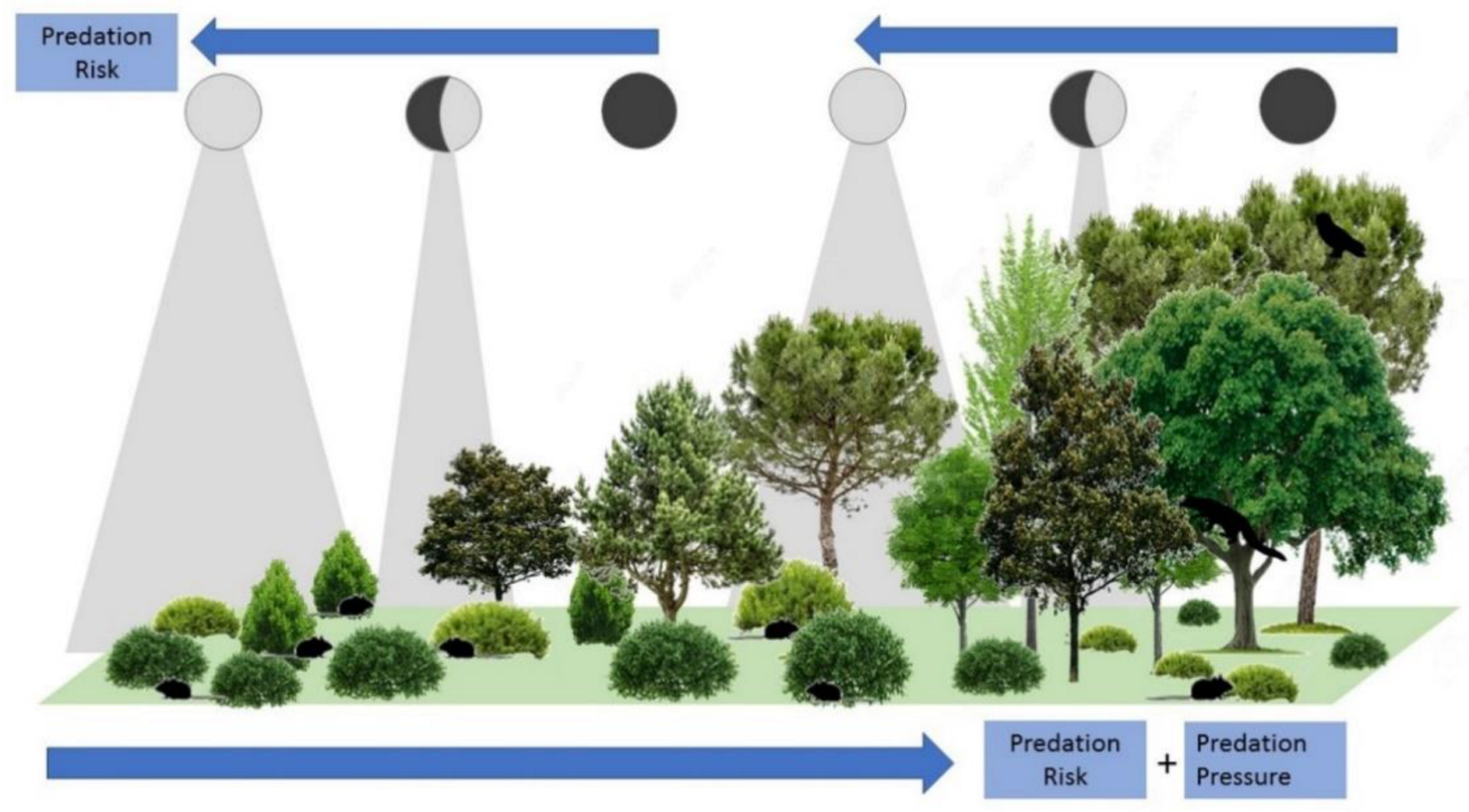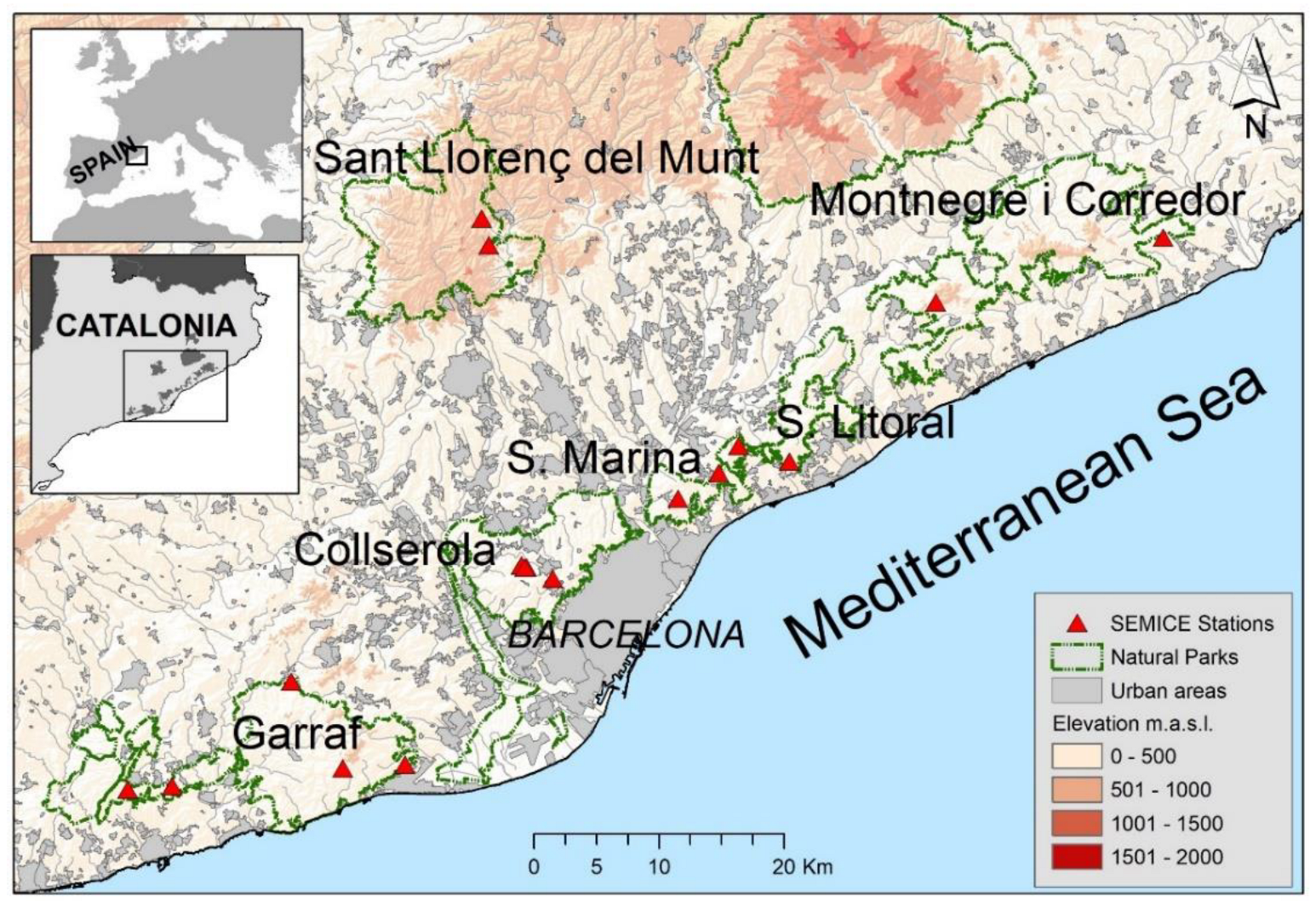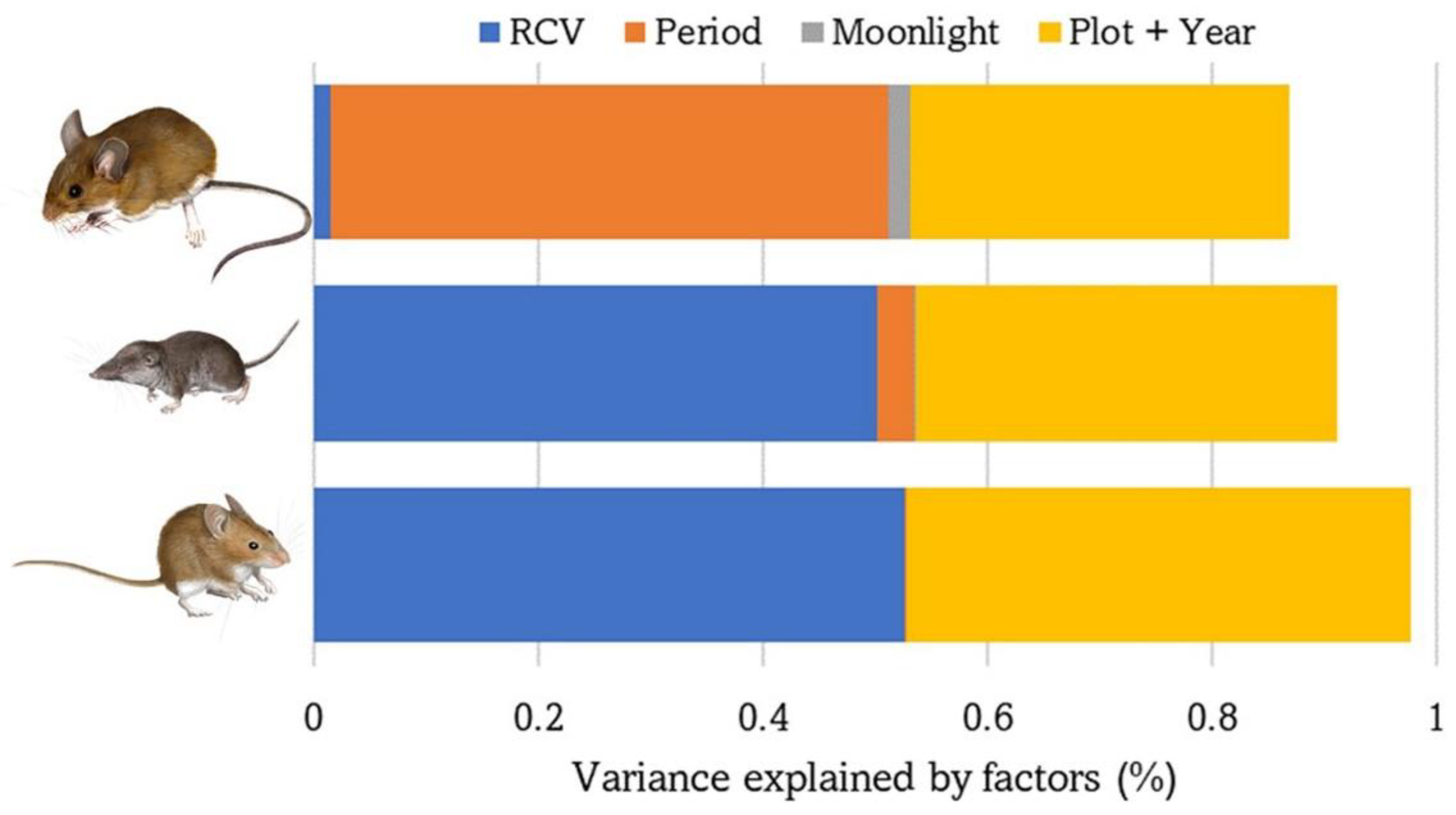Indirect Human Influences in Fear Landscapes: Varying Effects of Moonlight on Small Mammal Activity along Man-Made Gradients of Vegetation Structure
Abstract
1. Introduction
2. Materials and Methods
2.1. Study Area
2.2. Small Mammal Sampling
2.3. Data Analysis
3. Results
4. Discussion
4.1. Moonlight Affects the Activity of Common Small Mammals
4.2. Moonlight Effects Modulated by Vegetation Structure. Comparison of Open/Closed Habitats
4.3. Conclusions
Author Contributions
Funding
Institutional Review Board Statement
Informed Consent Statement
Data Availability Statement
Acknowledgments
Conflicts of Interest
References
- Caro, T. Antipredator Defenses in Birds and Mammals; University of Chicago Press: Chicago, IL, USA, 2005. [Google Scholar]
- Prugh, L.R.; Golden, C.D. Does moonlight increase predation risk? Meta-analysis reveals divergent responses of nocturnal mammals to lunar cycles. J. Anim. Ecol. 2014, 83, 504–514. [Google Scholar] [CrossRef] [PubMed]
- Griffin, P.C.; Griffin, S.C.; Waroquiers, C.; Mills, L.S. Mortality by moonlight: Predation risk and the snowshoe hare. Behav. Ecol. 2005, 16, 938–944. [Google Scholar] [CrossRef]
- Brown, J.S.; Kotler, B.P.; Smith, R.J.; Wirtz, W.O. The effects of owl predation on the foraging behavior of heteromyid rodents. Oecologia 1988, 76, 408–415. [Google Scholar] [CrossRef] [PubMed]
- Cooper, W.E.; Blumstein, D.T. Escaping from Predators: An Integrative View of Escape Decisions; Cooper, W.E., Blumstein, D.T., Eds.; Cambridge University Press: Cambridge, UK, 2015. [Google Scholar]
- Orrock, J.L.; Danielson, B.J.; Brinkerhoff, R.J. Rodent foraging is affected by indirect, but not by direct, cues of predation risk. Behav. Ecol. 2004, 15, 433–437. [Google Scholar] [CrossRef]
- Kotler, B.P.; Brown, J.S.; Hasson, O. Factors affecting gerbil foraging behavior and rates of owl predation. Ecology 1991, 72, 2249–2260. [Google Scholar] [CrossRef]
- Brown, J.S. Patch use as an indicator of habitat preference, predation risk, and competition. Behav. Ecol. Sociobiol. 1988, 22, 37–47. [Google Scholar] [CrossRef]
- Abom, R.; Schwarzkopf, L. Differential behavioural flexibility in response to predation risk in native and introduced tropical savannah rodents. Anim. Behav. 2016, 122, 117–124. [Google Scholar] [CrossRef]
- Gilbert, B.S.; Boutin, S. Effect of Moonlight on Winter Activity of Showshoe Hares. Arct. Alp. Res. 1991, 23, 61. [Google Scholar] [CrossRef]
- Díaz, M.; Torre, I.; Peris, A.; Tena, L. Foraging behavior of wood mice as related to presence and activity of genets. J. Mammal 2005, 86, 1178–1185. [Google Scholar] [CrossRef]
- Morán-López, T.; Sánchez-Dávila, J.; Torre, I.; Navarro-Castilla, Á.; Barja, I.; Díaz, M. Ungulate presence and predation risks reduce acorn predation by mice in dehesas. PLoS ONE 2022, 17, e0260419. [Google Scholar] [CrossRef]
- Díaz, M. Rodent seed predation in cereal crop areas of Central Spain: Effects of physiognomy, food availability, and predation risk. Ecography 1992, 15, 77–85. [Google Scholar] [CrossRef]
- Navarro-Castilla, Á.; Barja, I. Does predation risk, through moon phase and predator cues, modulate food intake, antipredatory and physiological responses in wood mice (Apodemus sylvaticus)? Behav. Ecol. Sociobiol. 2014, 68, 1505–1512. [Google Scholar] [CrossRef]
- Perea, R.; González, R.; San Miguel, A.; Gil, L. Moonlight and shelter cause differential seed selection and removal by rodents. Anim. Behav. 2011, 82, 717–723. [Google Scholar] [CrossRef]
- Loggins, A.A.; Shrader, A.M.; Monadjem, A.; McCleery, R.A. Shrub cover homogenizes small mammals’ activity and perceived predation risk. Sci. Rep. 2019, 9, 16857. [Google Scholar] [CrossRef]
- Navarro-Castilla, Á.; Barja, I.; Díaz, M. Foraging, feeding, and physiological stress responses of wild wood mice to increased illumination and common genet cues. Curr. Zool. 2018, 64, 409–417. [Google Scholar] [CrossRef]
- Viviano, A.; Mazza, G.; Di Lorenzo, T.; Mori, E. Housed in a lodge: Occurrence of animal species within Eurasian beaver constructions in Central Italy. Eur. J. Wildl. Res. 2022, 68, 75. [Google Scholar] [CrossRef]
- Navarro, L.M.; Pereira, H.M. Rewilding abandoned landscapes in Europe. In Rewilding European Landscapes; Springer International Publishing: Berlin/Heidelberg, Germany, 2015; pp. 3–23. [Google Scholar] [CrossRef]
- Torre, I.; Jaime-González, C.; Díaz, M. Habitat Suitability for Small Mammals in Mediterranean Landscapes: How and Why Shrubs Matter. Sustainability 2022, 14, 1562. [Google Scholar] [CrossRef]
- Torre, I.; Pulido, T.; Vilella, M.; Díaz, M. Mesocarnivore Distribution along Gradients of Anthropogenic Disturbance in Mediterranean Landscapes. Diversity 2022, 14, 133. [Google Scholar] [CrossRef]
- Torre, I.; Raspall, A.; Arrizabalaga, A.; Díaz, M. SEMICE: An Unbiased and Powerful Monitoring Protocol for Small Mammals in the Mediterranean Region. Mamm. Biol. 2018, 88, 161–167. [Google Scholar] [CrossRef]
- Torre, I.; López-Baucells, A.; Stefanescu, C.; Freixas, L.; Flaquer, C.; Bartrina, C.; Coronado, A.; López-Bosch, D.; Mas, M.; Míguez, S.; et al. Concurrent Butterfly, Bat and Small Mammal Monitoring Programmes Using Citizen Science in Catalonia (NE Spain): A Historical Review and Future Directions. Diversity 2021, 13, 454. [Google Scholar] [CrossRef]
- Garden, J.G.; Mcalpine, C.A.; Possingham, H.P.; Jones, D.N. Habitat structure is more important than vegetation composition for local-level management of native terrestrial reptile and small mammal species living in urban remnants: A case study from Brisbane, Australia. Austral Ecol. 2007, 32, 669–685. [Google Scholar] [CrossRef] [PubMed]
- Jaime-González, C.; Acebes, P.; Mateos, A.; Mezquida, E.T. Bridging gaps: On the performance of airborne LiDAR to model wood mouse-habitat structure relationships in pine forests. PLoS ONE 2017, 12, e0182451. [Google Scholar] [CrossRef] [PubMed]
- Schooler, S.L.; Zald, H.S.J. Lidar Prediction of Small Mammal Diversity in Wisconsin, USA. Remote Sens. 2019, 11, 2222. [Google Scholar] [CrossRef]
- Buesching, C.D.; Newman, C.; Twell, R.; Macdonald, D.W. Reasons for arboreality in wood mice Apodemus sylvaticus and Bank voles Myodes glareolus. Mamm. Biol. 2008, 73, 318–324. [Google Scholar] [CrossRef]
- Vignoli, L.; Luiselli, L. Better in the dark: Two Mediterranean amphibians synchronize reproduction with moonlit nights. Web Ecol. 2013, 13, 1–11. [Google Scholar] [CrossRef]
- Bissattini, A.M.; Buono, V.; Vignoli, L. Moonlight rather than moon phase influences activity and habitat use in an invasive amphibian predator and its native amphibian prey. Acta Oecol. 2020, 103, 103529. [Google Scholar] [CrossRef]
- Onorati, M.; Vignoli, L. The darker the night, the brighter the stars: Consequences of nocturnal brightness on amphibian reproduction. Biol. J. Linn. Soc. 2017, 120, 961–976. [Google Scholar] [CrossRef]
- Dell’Agnello, F.; Martini, M.; Mori, E.; Mazza, G.; Mazza, V.; Zaccaroni, M. Winter activity rhythms of a rodent pest species in agricultural habitats. Mammal Res. 2020, 65, 69–74. [Google Scholar] [CrossRef]
- Mori, E.; Sangiovanni, G.; Corlatti, L. Gimme shelter: The effect of rocks and moonlight on occupancy and activity pattern of an endangered rodent, the garden dormouse Eliomys quercinus. Behav. Process. 2020, 170, 103999. [Google Scholar] [CrossRef]
- Bolker, B.M.; Brooks, M.E.; Clark, C.J.; Geange, S.W.; Poulsen, J.R.; Stevens, M.H.H.; White, J.S.S. Generalized linear mixed models: A practical guide for ecology and evolution. Trends Ecol. Evol. 2009, 24, 127–135. [Google Scholar] [CrossRef]
- RStudio Team. RStudio: Integrated Development for R. RStudio, PBC, Boston, MA, 2020. Available online: http://www.rstudio.com/ (accessed on 20 January 2022).
- Bates, D.; Mächler, M.; Bolker, B.M.; Walker, S. Fitting linear mixed-effects models using lme4. J. Stat. Softw. 2015; 67, preprint. [Google Scholar] [CrossRef]
- Nakagawa, S.; Schielzeth, H. A general and simple method for obtaining R2 from generalized linear mixed-effects models. Methods Ecol. Evol. 2013, 4, 133–142. [Google Scholar] [CrossRef]
- Stefanescu, C.; Soldevila, A.; Gutiérrez, C.; Torre, I.; Ubach, A.; Miralles, M. Explosions demogràfiques de l’eruga peluda del suro, Lymantria dispar (Linnaeus, 1758), als boscos del Montnegre el 2019 i 2020: Possibles causes, impactes i idoneïtat dels tractaments per combatre la plaga. Butlletí Inst. Catalana D’història Nat. 2020, 84, 267–279. [Google Scholar]
- Oro, D.; Sanz-Aguilar, A.; Carbonell, F.; Grajera, J.; Torre, I. Multi-species prey dynamics influences local survival in resident and wintering generalist predators. Oecologia 2021, 197, 437–446. [Google Scholar] [CrossRef]
- Torre, I.; Arrizabalaga, A.; Díaz, M. Ratón de campo Apodemus sylvaticus (Linnaeus, 1758). Galemys 2002, 14, 1–26. [Google Scholar]
- Viviano, A.; Scarfò, M.; Mori, E. Temporal Partitioning between Forest-Dwelling Small Rodents in a Mediterranean Deciduous Woodland. Animals 2022, 12, 279. [Google Scholar] [CrossRef]
- Genoud, M. Ecological energetics of two European shrews: Crocidura russula and Sorex coronatus (Soricidae: Mammalia). J. Zool. 1985, 207, 63–85. [Google Scholar] [CrossRef]
- Cantoni, D.; Vogel, P. Social organization and mating system of free ranging, greater white-toothed shrews, Crocidura russula. Anim. Behav. 1989, 38, 205–214. [Google Scholar] [CrossRef]
- Palomo, L.J.; Justo, E.R.; Vargas, J.M. Mus spretus (Rodentia: Muridae). Mamm. Species 2009, 840, 1–10. [Google Scholar] [CrossRef]
- Saarikko, J. Risk of predation and foraging activity in shrews. Ann. Zool. Fenn. 1992, 29, 291–299. [Google Scholar]
- Turbill, C.; Stojanovski, L. Torpor reduces predation risk by compensating for the energetic cost of antipredator foraging behaviours. Proc. R. Soc. B 2018, 285, 20182370. [Google Scholar] [CrossRef] [PubMed]
- Gallego, D.; Morán-López, T.; Torre, I.; Navarro-Castilla, Á.; Barja, I.; Díaz, M. Context Dependence of Acorn Handling by the Algerian Mouse (Mus Spretus). Acta Oecol. 2017, 84, 1–7. [Google Scholar] [CrossRef]
- Torre, I.; Díaz, M. Small mammal abundance in Mediterranean post-fire habitats: A role for predators? Acta Oecol. 2004, 25, 137–143. [Google Scholar] [CrossRef]




| Models | Apodemus sylvaticus | Crocidura russula | Mus spretus | |
|---|---|---|---|---|
| Mod. nº 1. Abundance ~ Moonlight + Period + RCV > 2.5 m + RCV < 1 m | Marginal R2 | 0.50 | 0.54 | 0.55 |
| Conditional R2 | 0.91 | 0.95 | 0.99 | |
| Mod. nº 2. Abundance ~ Moonlight | Marginal R2 | 0.02 | 0.00 | 0.00 |
| Conditional R2 | 0.84 | 0.95 | 0.98 | |
| Mod. nº 3. Abundance ~ Period | Marginal R2 | 0.50 | 0.03 | 0.00 |
| Conditional R2 | 0.91 | 0.95 | 0.98 | |
| Mod. nº 4. Abundance ~ RCV > 2.5 m | Marginal R2 | 0.02 | 0.50 | 0.52 |
| Conditional R2 | 0.82 | 0.95 | 0.98 | |
| Mod. nº 5. Abundance ~ RCV < 1 m | Marginal R2 | 0.01 | 0.44 | 0.47 |
| Conditional R2 | 0.82 | 0.95 | 0.98 | |
| Mod. nº 6. Abundance ~ Moonlight * RCV > 2.5 m | Marginal R2 | 0.05 | 0.50 | 0.53 |
| Conditional R2 | 0.84 | 0.95 | 0.98 | |
| Mod. nº 7. Abundance ~ Moonlight * RCV < 1 m | Marginal R2 | 0.05 | 0.44 | 0.48 |
| Conditional R2 | 0.84 | 0.95 | 0.98 | |
| Mod. nº 8. Abundance ~ Moonlight * Period | Marginal R2 | 0.48 | 0.03 | 0.01 |
| Conditional R2 | 0.92 | 0.95 | 0.98 |
| Apodemus sylvaticus | Crocidura russula | Mus spretus | |
|---|---|---|---|
| Moonlight | −0.06 *** (0.01) | - | 0.20 *** (0.04) |
| RCV > 2.5 m | - | −0.04 *** (0.01) | −0.04 ** (0.01) |
| RCV < 1 m | - | - | - |
| Period (Autumn) | −1.66 *** (0.11) | 0.60 *** (0.01) | 1.08 *** (0.24) |
| Moonlight * RCV > 2.5 m | - | - | −0.00 *** (0.00) |
| Moonlight * RCV < 1 m | - | - | - |
| Moonlight * Period | 0.04 * (0.02) | - | −0.13 ** (0.04) |
Disclaimer/Publisher’s Note: The statements, opinions and data contained in all publications are solely those of the individual author(s) and contributor(s) and not of MDPI and/or the editor(s). MDPI and/or the editor(s) disclaim responsibility for any injury to people or property resulting from any ideas, methods, instructions or products referred to in the content. |
© 2023 by the authors. Licensee MDPI, Basel, Switzerland. This article is an open access article distributed under the terms and conditions of the Creative Commons Attribution (CC BY) license (https://creativecommons.org/licenses/by/4.0/).
Share and Cite
Pasquet, A.; Torre, I.; Díaz, M. Indirect Human Influences in Fear Landscapes: Varying Effects of Moonlight on Small Mammal Activity along Man-Made Gradients of Vegetation Structure. Life 2023, 13, 681. https://doi.org/10.3390/life13030681
Pasquet A, Torre I, Díaz M. Indirect Human Influences in Fear Landscapes: Varying Effects of Moonlight on Small Mammal Activity along Man-Made Gradients of Vegetation Structure. Life. 2023; 13(3):681. https://doi.org/10.3390/life13030681
Chicago/Turabian StylePasquet, Alba, Ignasi Torre, and Mario Díaz. 2023. "Indirect Human Influences in Fear Landscapes: Varying Effects of Moonlight on Small Mammal Activity along Man-Made Gradients of Vegetation Structure" Life 13, no. 3: 681. https://doi.org/10.3390/life13030681
APA StylePasquet, A., Torre, I., & Díaz, M. (2023). Indirect Human Influences in Fear Landscapes: Varying Effects of Moonlight on Small Mammal Activity along Man-Made Gradients of Vegetation Structure. Life, 13(3), 681. https://doi.org/10.3390/life13030681







